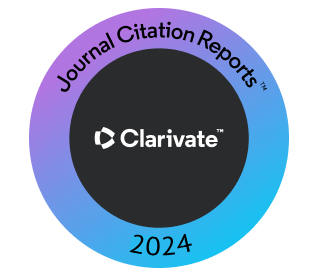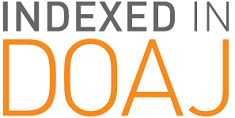Factors Controlling the Development of Wine-Glass Forms in the Mountains of the Kurdistan Region, Iraq
Abstract
The northern and northeastern parts of Iraq are mountainous areas and rugged topography with different erosional and morphological forms; among them are the wine-glass (erosional cirques) forms. They are developed in different shapes, sizes, and depths. In the outlets of the wine-glass forms; usually, alluvial fans are formed. The studied area is characterized by the presence of long and narrow anticlines with NW–SE trend that changes westward to E–W trend. The Cretaceous carbonate rocks form the main carapace of the majority of the mountains; however, locally Paleogene and/or Jurassic rocks form the carapace. In the core, rocks down to Devonian are exposed. In those anticlines where only Cretaceous rocks are exposed, no or very rarely wine-glass forms are developed. This is attributed to the Cretaceous carbonate rocks, which exist in huge thicknesses in many formations, with thickly bedded to massive nature and very hard erosion resisting rocks. Tens of the existing wineglass forms are studied to indicate the factors that control their development, which are the type of exposed rocks, their thicknesses, and hardness. To perform the aim of this study, different satellite imagery with different resolutions was used; besides using GIS technique and field check to improve the acquired date.
Downloads
References
Alden, A., 2014. Erosional Landforms. In: GEO ExPro Magazine.
Al-Jaf, A.A. and Kadhim, T.H., 2010. The Geomorphological Map of Kirkuk Quadrangle, Sheet No. N1-38-2, Scale 1:250000. Iraq Geological Survey Library, Report No. 3297, Baghdad, Iraq.
Al-Ma’amar, A.F., Al-Saady, Y.I. and Al-Saati, R.M., 2011. Series of Geomorphological Maps of Iraq, scale 1: 250000, Erbil and Mahabad Quadrangles, Sheets No. NJ–38–14 and NJ–38–15. Iraq Geological Survey Library, Report No. 3358.
Al-Mousawi, H.A., Sissakian, V.K. and Fouad, S.F., 2008. The Geology of Zakho Quadrangle, Scale 1:250000. Iraq Geological Survey Publications, Baghdad, Iraq.
Bahrami, S., 2012. Morphotectonic evolution of triangular facets and wine-glass valleys in the Noakoh anticline, Zagros, Iran: Implications for active tectonics. Geomorphology, 159-160, pp.37-49.
Burbank, D.W. and Anderson, R.S., 2000. Tectonic Geomorphology. Wiley, New York.
Burbank, D.W. and Pinter, N., 1999. Landscape evolution: The interactions of tectonics and surface processes. Basin Research, 11(1), pp.1-6.
Burbank, D.W., McLean, J.K., Bullen, M.Y. and Miller, M.M., 1999. Partitioning of intermontane basins by thrust-related folding. TienShan, Kyrgyzstan. Basin Research, 11(1), pp.75-92.
DigitalGlobe, 2006. Quickbird Imagery Products: Product Guide, 4.7.1 ed. DigitalGlobe, Inc., Longmont, CO., USA.
Evans, I.S. and Cox, N., 1974. Geomorphometry and the operational definition of cirques. The Royal Geographical Society, 6(2), pp.150-153.
Fouad, S.F., 2007. The Geology of Kani Rash Quadrangle, Scale 1:250000. Iraq Geological Survey Publications, Baghdad, Iraq. Fouad, S.F., 2012a. Tectonic Map of Iraq, Scale 1:1000 000. 3rd ed. Iraq Geological Survey Publications, Baghdad, Iraq.
Fouad, S.F., 2012b. Western zagros thrust-fold belt. Part 1: The low folded zone. In: Geology of the low folded zone. Iraqi Bulletin of Geology and Mining, 5, pp.39-62.
Fouad, S.F.A. and Nasir, W.A.A., 2009. Tectonic and structural evolution. In: Geology of Al-Jazira area. Iraqi Bulletin of Geology and Mining, 3, pp.33-48.
Gornitz, V., 2009. Encyclopedia of Paleoclimatology and Ancient Environments. 1st ed. Springer, Netherlands. Hamza, N.M., 1997. Geomorphological Map of Iraq, Scale 1:1000 000. Iraq Geological Survey Publications, Baghdad, Iraq.
Huggett, R., 2007. Routledge Fundamentals of Physical Geography. In: Fundamentals of Geomorphology. 2nd ed. Taylor and Francis, London. Keller, E.A. and Pinter, N., 2002.
Hall earth science series. In: Active Tectonics: Earthquakes, Uplift, and Landscape. Prentice Hall, New Jersey.
Mitchell, S.G. and Humphries, E.E., 2014. Glacial cirques and the relationship between equilibrium line altitudes and mountain range height. Geology, 43(1), pp.35-38.
Othman, A.A. and Gloaguen, R., 2013a. River courses affected by landslides and implications for hazard assessment: A high resolution remote sensing case study in NE Iraq-W Iran. Remote Sensing, 5(3), pp.1024-1044.
Othman, A.A. and Gloaguen, R., 2013b. Automatic extraction and size distribution of landslides in Kurdistan region, NE Iraq. Remote Sensing, 5(5), pp.2389-2410.
Othman, A.A. and Gloaguen, R., 2014. Improving lithological mapping by SVM classification of spectral and morphological features: The discovery of a new chromite body in the mawat ophiolite complex (Kurdistan, NE Iraq). Remote Sensing, 6(8), pp.6867-6896.
Ramsey, L.A., Walker, R.T. and Jackson, J., 2008. Fold evolution and drainage development in the Zagros mountains of Fars province, SE Iran. Basin Research, 20(1), pp.23-48.
Sissakian, V.K. and Abdul-Jab’bar, M.F., 2010. Morphometry and genesis of the main transversal gorges in North and Northeast Iraq. Iraqi Bulletin of Geology and Mining, 6(1), pp.95-120.
Sissakian, V.K. and Al-Jibouri, B.S., 2014. Stratigraphy, In: Geology of the high folded zone. Iraqi Bulletin of Geology and Mining, 6, pp.73-16.
Sissakian, V.K. and Fouad, S.F., 2012. Geological Map of Iraq, Scale 1:1000 000. 4th ed. Iraq Geological Survey Publications, Baghdad-Iraq. Available from: http:// www.iasj.net/iasj?func=fulltext&aId=99666. [Last accessed on 2017 Nov 12].
Sissakian, V.K. and Fouad, S.F., 2014a. The Geology of Sulaimaniyah Quadrangles, Scale 1:250 000, Sheet No. NI–38–03. 2nd ed. Iraq Geological Survey Publications, Baghdad, Iraq.
Sissakian, V.K. and Fouad, S.F., 2014b. The Geology of Erbil and Mahabad Quadrangles, Scale 1:250 000, Sheets No. NJ–38–14 and NJ–38–15. 2nd ed. Iraq Geological Survey Publications, Baghdad, Iraq.
Sissakian, V.K. and Fouad, S.F., 2014c. The Geology of Kirkuk Quadrangle, Scale 1:250 000, Sheet No. NI–38–2. 2nd ed. Iraq Geological Survey Publications, Baghdad, Iraq.
Sissakian, V.K. and Ibrahim, F.A., 2004a. Geological Hazards Map of Mosul Quadrangle, Scale 1:250 000, Sheet No. NJ–38–03. In: Iraq Geological Survey Library, Report No. 2860.
Sissakian, V.K. and Ibrahim, F.A., 2004b. Geological Hazards Map of Erbil and Mahabad Quadrangles, Scale 1: 250 000, Sheets No. NJ–38–14 and NJ–38–15. In: Iraq Geological Survey Library, Report No. 2878.
Sissakian, V.K. and Ibrahim, F.A., 2005. Geological Hazards Map of Iraq, Scale 1:1000 000. Iraq Geological Survey Publications, Baghdad, Iraq.
Sissakian, V.K. and Saeed, Z.B., 2012. Lithological map of Iraq, compiled using GIS techniques. Iraqi Bulletin of Geology and Mining, 8(3), pp.1-13.
Sissakian, V.K. and Youkhanna, R.Y., 1979. Report on Regional Geological Mapping of Erbil–Shaqlawa–Koi Sanjaq–Raidar Area. In: Iraq Geological Survey Library, Report No. 975.
Sissakian, V.K., 1993. Geological Report on Kirkuk Quadrangle, Sheet No. NI–38–02, Scale 1:250 000. Iraq Geological Survey Publications, Baghdad, Iraq.
Sissakian, V.K., 1995. Geological Report on Al-Mosul Quadrangle, Sheet No. NJ–38–03, Scale 1:250 000. Iraq Geological Survey Publications, Baghdad, Iraq.
Sissakian, V.K., 2010. Neotectonic movements in Darbandi Bazian area, Southwest of Sulaimaniyah city, NE Iraq. Iraqi Bulletin of Geology and Mining, 6(2), pp.57-69.
Sissakian, V.K., 2013. Geomorphology and morphometry of the greater Zab river basin, North of Iraq. Iraqi Bulletin of Geology and Mining, 9(3), pp.21-49.
Sissakian, V.K., Kadhum, T.H. and Jab’bar, M.A., 2014. Geomorphology. In: Geology of the high folded zone. Iraqi Bulletin of Geology and Mining, 6, pp.7-56.
Sissakian, V.K., Qambar, A.S. and Ahad, A.D.A., 2008a. Geological Hazards Map of Zahko Quadrangle, Scale 1:250 000, Sheet No. NJ–38–9. Iraq Geological Survey Library, Report No. 3129.
Sissakian, V.K., Qambar, A.S. and Ahad, A.D.A., 2008b. Geological Hazards Map of Sulaimaniyah Quadrangle, Scale 1:250 000, Sheet No. NI–38–03. Iraq Geological Survey Library, Report No. 3075.
Sissakian, V.K., Qambar, A.S. and Ahad, A.D.A., 2008c. Geological Hazards Map of Kani Rash Quadrangle, Scale 1:250 000, Sheet No. NJ–38–10. Iraq Geological Survey Library, Report No. 3112.
Upton, B.G.J. and Wadsworth, W.J., 1969. Early volcanic rocks of réunion and their tectonic significance. Bulletin Volcanologique, 33(4), pp.1246-1268.
Van Bellen, R.C., Dunnington, H.V., Wetzel, R. and Morton, D., 1959. Lexique Stratigraphic International. Asie, Fasc, Iraq, Paris.
Ward, D., Saltz, D. and Olsvig-Whittaker, L., 2000. Distinguishing signal from noise: Long-term studies of vegetation in Makhtesh Ramon erosion cirque, Negev desert, Israel. Plant Ecology, 150(1-2), pp.27-36.
Wikipedia, 2014. Fluvial-Erosion Cirque Formation. Available from: https:// www.en.wikipedia.org/wiki/Cirque. [Last accessed on 2017 Aug 18].
Yacoub, S.Y., Othman, A.A. and Kadhum, T.H., 2012. Geomorphology. In: Geology of the low folded zone. Iraqi Bulletin of Geology and Mining, 5, pp.7-38. Youkhanna, R.Y. and
Sissakian, V.K., 1986. The Stratigraphy of the ShaqlawaKoisanjaq Area. In: Proceedings of the 7th Iraqi Geological Congress, 12 – 15/4/1986, Baghdad, Iraq
Copyright (c) 2018 Varoujan K. Sissakian, Arsalan Ahmed Othman, Ahmed Tariq Shihab

This work is licensed under a Creative Commons Attribution-NonCommercial-ShareAlike 4.0 International License.
Authors who choose to publish their work with Aro agree to the following terms:
-
Authors retain the copyright to their work and grant the journal the right of first publication. The work is simultaneously licensed under a Creative Commons Attribution License [CC BY-NC-SA 4.0]. This license allows others to share the work with an acknowledgement of the work's authorship and initial publication in this journal.
-
Authors have the freedom to enter into separate agreements for the non-exclusive distribution of the journal's published version of the work. This includes options such as posting it to an institutional repository or publishing it in a book, as long as proper acknowledgement is given to its initial publication in this journal.
-
Authors are encouraged to share and post their work online, including in institutional repositories or on their personal websites, both prior to and during the submission process. This practice can lead to productive exchanges and increase the visibility and citation of the published work.
By agreeing to these terms, authors acknowledge the importance of open access and the benefits it brings to the scholarly community.















 ARO Journal is a scientific, peer-reviewed, periodical, and diamond OAJ that has no APC or ASC.
ARO Journal is a scientific, peer-reviewed, periodical, and diamond OAJ that has no APC or ASC.